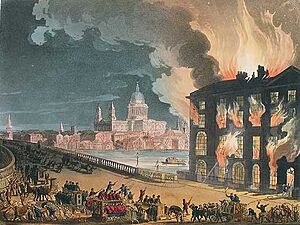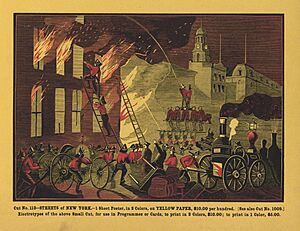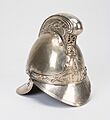History of firefighting facts for kids
The story of organized firefighting started a very long time ago in ancient Rome, when the first Roman Emperor, Augustus, was in charge. But even before that, a clever Greek inventor named Ctesibius from Alexandria created the first fire pump in the 200s BC. Later, another inventor, Hero of Alexandria, made it even better in the 100s BC.
Contents
Ancient Roman Firefighters
In ancient Rome, fires were a big problem because many buildings were close together and made of wood. To fight these fires, the Roman Emperor Nero created a special group of slaves called the Vigiles in AD 60. They used buckets of water, pumps, and even long poles and hooks to pull down buildings to stop fires from spreading. The Vigiles also patrolled the streets of Rome, acting a bit like a police force.
Before the Vigiles, Emperor Augustus, who ruled from 27 BC to 14 AD, had already started a basic firefighting group. This shows how important it was to deal with fires in the busy city.
One of the most famous fires in Rome was the Great Fire of Rome on July 19, AD 64. It was so huge that it destroyed two-thirds of the city!
Early Firefighting in Europe
For a long time, firefighting in Europe was quite basic. In 1254, King Saint Louis of France allowed people in Paris to form their own night watches, called guet bourgeois. These groups helped prevent crimes and fires. After a big war called the Hundred Years' War, Paris grew much larger. Many big fires happened in the 1500s. Because of this, King Charles IX decided that only the king's official watch would be in charge of stopping crimes and fires.
London also had many terrible fires, especially the Great Fire of London in 1666. This fire started in a baker's shop and burned down about 5 square kilometers (2 square miles) of the city. Tens of thousands of people lost their homes. Before this fire, London didn't have an organized way to fight fires. Afterward, insurance companies started their own private fire brigades to protect the properties they insured. These buildings often had special fire insurance marks to show which company insured them.
There's a common story that these private fire brigades would only put out fires at buildings insured by their company. But this isn't true! They would fight fires at any building.
New Firefighting Tools
A big step forward in firefighting happened in the 1600s with the invention of the first fire engines. These were manual pumps that could spray water. Early pumps had a very short range because they didn't have hoses.
A German inventor named Hans Hautsch made a better manual pump. He added flexible hoses to the pump, which meant firefighters could spray water much further. In 1672, a Dutch artist and inventor named Jan Van der Heyden created the fire hose as we know it. His hoses were made of flexible leather and could be connected together every 15 meters (50 feet) with brass fittings. This length is still common in many parts of Europe today.
Another Dutch inventor, John Lofting, who worked with Jan Van der Heyden, further improved the fire engine. He moved to London around 1688 and patented his "Sucking Worm Engine" in 1690. His invention was praised for its firefighting ability.
Later, in 1721, Richard Newsham in England patented an even better engine. These manual pumps were pulled to fires like carts and needed 4 to 12 men to operate them. They could spray a lot of water very far. Newsham's company continued to make these engines for many years. By 1792, Hadley, Simpkin & Lott co. developed a larger, improved hand-pumped engine that could be pulled by horses.

Firefighting in the United States
In early America, leaders quickly saw the need for fire safety. In 1631, the governor of Boston, John Winthrop, banned wooden chimneys and thatched roofs to prevent fires. In 1648, the governor of New Amsterdam (which is now New York City), Peter Stuyvesant, appointed four men to be fire wardens. They checked chimneys and fined people who didn't follow the rules.
Later, eight important citizens formed the "Rattle Watch." These volunteers patrolled the streets at night with large wooden rattles. If they saw a fire, they would shake their rattles loudly to alert everyone. Then, they would direct people to form bucket brigades, passing buckets of water hand-to-hand to the fire.
On January 27, 1678, the first fire engine company started in America. In 1736, Benjamin Franklin started the Union Fire Company in Philadelphia.
For a long time, the United States didn't have fire departments run by the government. Instead, private fire brigades would compete to be the first to arrive at a fire. This was because insurance companies would pay the brigades that saved buildings. The first known female firefighter, Molly Williams, helped pull a fire pumper through deep snow during a blizzard in 1818.
On April 1, 1853, Cincinnati, Ohio, became home to the first fire department in the United States made up entirely of full-time, paid firefighters. Today, many firefighters in the U.S. are still volunteers. In 2015, only 4% of emergency calls were for actual fires, while most were for medical help or false alarms.
Firefighting in Canada
The first organized fire department in Canada was formed in Halifax, Nova Scotia. It was originally called the Union Fire Club. Other early fire companies in Canada, started in the 1780s, were also set up as groups that offered both insurance and fire protection.
Modern Firefighting Developments
The world's oldest firefighter organization is in Lisbon, Portugal. It was created in 1395 and is now called "Regimento de Sapadores Bombeiros de Lisboa."
In the early 1700s, the first fire brigades in the modern sense were created in France. In 1699, a businessman named François du Mouriez du Périer showed King Louis XIV the new fire pumps. The king was very impressed and gave him the right to make and sell these "fire-preventing portable pumps" all over France.
François du Mouriez du Périer gave 12 pumps to the City of Paris. This led to the creation of the first Paris Fire Brigade in 1716, called the Compagnie des gardes-pompes (which means "Company of Pump Guards"). François du Mouriez du Périer became the chief of this brigade, and his family held the position until 1760. Soon, other large French cities also created fire brigades. This is also when the French word pompier (firefighter) appeared, which literally means "pumper."
On March 11, 1733, the French government made a very important decision: fire brigade services would be free. This was because people were waiting until the very last moment to call firefighters to avoid paying, and by then, it was often too late to stop the fires. From 1750 onwards, French fire brigades became more like military units and started wearing uniforms. In 1756, King Louis XV suggested that firefighters wear protective helmets, but it took many more years for this to become common.
In North America, Jamestown, Virginia, was almost completely destroyed by fire in 1608. For a long time, there were no full-time paid firefighters in America until 1850. Even after paid fire companies started, there were often disagreements and even fights over which company would get to fight a fire and receive money from insurance companies. In New York City, companies would send fast runners to fires with a large barrel to cover the fire hydrant closest to the blaze. Fights would often break out between these runners and even the fire companies themselves over the right to fight the fire.
During the 1800s and early 1900s, volunteer fire companies were not just about putting out fires; they were also important in local politics. A famous politician named Boss Tweed, who led the powerful Tammany Hall political group, started his career as a member of a volunteer fire company in New York City.
Napoleon Bonaparte is often given credit for creating the first "professional" firefighters, known as Sapeurs-Pompiers ("Sappers-Firefighters"), who were part of the French Army. This group was formed in 1810 after a fire at the Austrian Embassy in Paris injured several important people.
In the UK, the Great Fire of London in 1666 led to big changes. After the fire, the City Council started the first fire insurance company, "The Fire Office," in 1667. This company hired small teams of watermen from the River Thames as firefighters and gave them uniforms and arm badges.
However, the first organized city-run fire brigade in the world was created in Edinburgh, Scotland, in 1824. It was called the Edinburgh Fire Engine Establishment and was led by James Braidwood. London followed in 1832 with its own London Fire Engine Establishment.
On April 1, 1853, the Cincinnati Fire Department became the first full-time paid fire department in the United States. It was also the first in the world to use steam fire engines.
The first horse-drawn steam engine for fighting fires was invented in England in 1829. But it wasn't widely used for fighting building fires until 1860. Self-propelled steam-powered fire engines, which could move on their own, were introduced in 1903. Soon after, in 1905, fire trucks with internal combustion engines (like cars) began to be made. This led to horse-drawn, hand-pumped, and steam-powered fire engines slowly disappearing by the mid-1920s.
Images for kids
See also
- Bombay Explosion (1944)
- Firematic Racing
- Great Fire of London
- List of fire departments
- List of fires
- History of the Belfast Fire Brigade
- Fires in Edo






